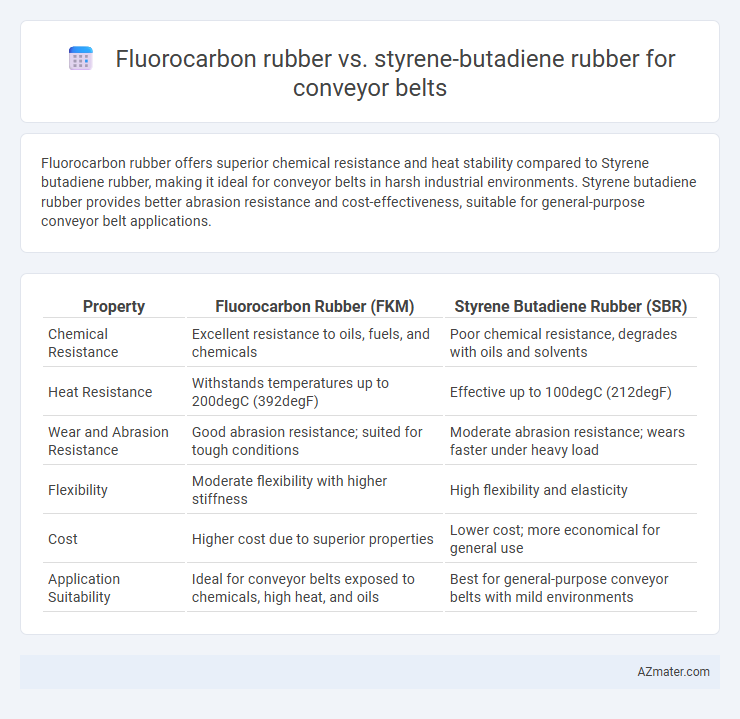Fluorocarbon rubber offers superior chemical resistance and heat stability compared to Styrene butadiene rubber, making it ideal for conveyor belts in harsh industrial environments. Styrene butadiene rubber provides better abrasion resistance and cost-effectiveness, suitable for general-purpose conveyor belt applications.
Table of Comparison
| Property | Fluorocarbon Rubber (FKM) | Styrene Butadiene Rubber (SBR) |
|---|---|---|
| Chemical Resistance | Excellent resistance to oils, fuels, and chemicals | Poor chemical resistance, degrades with oils and solvents |
| Heat Resistance | Withstands temperatures up to 200degC (392degF) | Effective up to 100degC (212degF) |
| Wear and Abrasion Resistance | Good abrasion resistance; suited for tough conditions | Moderate abrasion resistance; wears faster under heavy load |
| Flexibility | Moderate flexibility with higher stiffness | High flexibility and elasticity |
| Cost | Higher cost due to superior properties | Lower cost; more economical for general use |
| Application Suitability | Ideal for conveyor belts exposed to chemicals, high heat, and oils | Best for general-purpose conveyor belts with mild environments |
Introduction to Conveyor Belt Materials
Fluorocarbon rubber offers exceptional chemical resistance, heat stability, and durability, making it ideal for conveyor belts in harsh industrial environments. Styrene butadiene rubber (SBR) provides good abrasion resistance and cost-effectiveness, commonly used in general-purpose conveyor belts for moderate conditions. Selecting between fluoroelastomer and SBR depends on operational requirements such as temperature range, exposure to oils or chemicals, and mechanical wear.
Overview: Fluorocarbon Rubber (FKM)
Fluorocarbon Rubber (FKM) offers superior chemical resistance and high-temperature durability compared to Styrene Butadiene Rubber (SBR), making it ideal for conveyor belts exposed to harsh industrial environments. The molecular structure of FKM provides exceptional resistance to oils, fuels, and solvents, as well as maintaining flexibility in temperatures ranging from -20degC to 200degC. In contrast, SBR is more suited for abrasion resistance and cost-effective applications but lacks the advanced chemical and thermal resilience of fluorocarbon rubber.
Overview: Styrene Butadiene Rubber (SBR)
Styrene Butadiene Rubber (SBR) is widely used in conveyor belts due to its excellent abrasion resistance and cost-effectiveness compared to Fluorocarbon rubber. SBR offers good mechanical properties and resilience, making it suitable for bulk material handling and industrial applications where durability is essential. While Fluorocarbon rubber provides superior chemical and heat resistance, SBR remains a preferred choice for general-purpose conveyor belts due to its balanced performance and affordability.
Chemical Resistance Comparison
Fluorocarbon rubber (FKM) exhibits superior chemical resistance compared to Styrene Butadiene Rubber (SBR), particularly against oils, fuels, solvents, and acids, making it ideal for conveyor belts exposed to harsh chemical environments. SBR offers moderate resistance primarily to aqueous solutions and alkalis but degrades rapidly when in contact with hydrocarbons and aromatic solvents. For conveyor belt applications requiring durability in aggressive chemical exposure, fluorocarbon rubber ensures enhanced longevity and performance over Styrene Butadiene Rubber.
Temperature Resistance Analysis
Fluorocarbon rubber (FKM) exhibits superior temperature resistance compared to Styrene Butadiene Rubber (SBR) in conveyor belt applications, maintaining stability at temperatures up to 250degC, whereas SBR typically withstands temperatures only up to 70degC. The enhanced thermal endurance of FKM is due to its strong carbon-fluorine bonds, which resist heat aging and oxidation, making it ideal for high-temperature industrial environments. In contrast, SBR's limited heat resistance leads to faster degradation, cracking, and loss of mechanical properties under elevated temperatures.
Mechanical Properties and Durability
Fluorocarbon rubber (FKM) offers superior chemical resistance, heat stability up to 200degC, and excellent mechanical strength, making it highly durable for conveyor belts operating in harsh chemical or high-temperature environments. Styrene butadiene rubber (SBR) provides good abrasion resistance, flexibility, and cost-effectiveness but performs poorly under oil exposure and elevated temperatures, limiting its durability in aggressive applications. Conveyor belts made with FKM exhibit extended service life and enhanced resistance to swelling, cracking, and wear, whereas SBR belts are suitable for general-purpose use with moderate mechanical demands.
Cost Implications
Fluorocarbon rubber offers superior chemical resistance and durability for conveyor belts but comes with significantly higher manufacturing and material costs compared to styrene butadiene rubber (SBR). Styrene butadiene rubber is more cost-effective and widely used in general-purpose conveyor belts, though it may require more frequent replacement in harsh environments due to lower resistance to abrasion and chemicals. The decision between fluorocarbon rubber and SBR directly impacts long-term operational expenses, where initial investments in fluorocarbon materials can be offset by reduced maintenance and extended belt life.
Suitability for Different Conveyor Belt Applications
Fluorocarbon rubber offers exceptional chemical resistance and high-temperature stability, making it suitable for conveyor belts in harsh environments such as chemical processing and oil refineries. Styrene butadiene rubber provides excellent abrasion resistance and flexibility at a lower cost, ideal for general material handling and mining industries where impact and wear are significant. Selecting between fluorocarbon and styrene butadiene rubber depends on specific application requirements, including exposure to chemicals, temperature ranges, and mechanical stress.
Environmental and Safety Considerations
Fluorocarbon rubber (FKM) offers superior chemical resistance and low permeability, making it ideal for conveyor belts exposed to harsh chemicals and extreme temperatures, thereby reducing environmental contamination risks. Styrene butadiene rubber (SBR) is more biodegradable and has a lower production carbon footprint, but its lower resistance to oils and solvents can lead to faster degradation and potential environmental hazards. Safety considerations favor FKM for applications requiring fire resistance and reduced toxic emissions during fires, while SBR requires additional fire retardants to meet safety standards.
Conclusion: Choosing the Right Rubber for Conveyor Belts
Fluorocarbon rubber offers superior chemical resistance, high-temperature tolerance, and excellent durability, making it ideal for conveyor belts in aggressive industrial environments. Styrene butadiene rubber provides cost-effective abrasion resistance and flexibility, suitable for general-purpose conveyor applications with moderate exposure. Selecting the right rubber depends on the specific operational demands, with fluorocarbon rubber preferred for harsh conditions and styrene butadiene rubber favored for budget-conscious, everyday uses.

Infographic: Fluorocarbon rubber vs Styrene butadiene rubber for Conveyor belt
 azmater.com
azmater.com